
eBook - ePub
Principles and Practice of Heterogeneous Catalysis
John Meurig Thomas, W. John Thomas
This is a test
Condividi libro
- English
- ePUB (disponibile sull'app)
- Disponibile su iOS e Android
eBook - ePub
Principles and Practice of Heterogeneous Catalysis
John Meurig Thomas, W. John Thomas
Dettagli del libro
Anteprima del libro
Indice dei contenuti
Citazioni
Informazioni sul libro
This long-awaited second edition of the successful introduction to the fundamentals of heterogeneous catalysis is now completely revised and updated.
Written by internationally acclaimed experts, this textbook includes fundamentals of adsorption, characterizing catalysts and their surfaces, the significance of pore structure and surface area, solid-state and surface chemistry, poisoning, promotion, deactivation and selectivity of catalysts, as well as catalytic process engineering. A final section provides a number of examples and case histories.
With its color and numerous graphics plus references to help readers to easily find further reading, this is a pivotal work for an understanding of the principles involved.
Domande frequenti
Come faccio ad annullare l'abbonamento?
È semplicissimo: basta accedere alla sezione Account nelle Impostazioni e cliccare su "Annulla abbonamento". Dopo la cancellazione, l'abbonamento rimarrà attivo per il periodo rimanente già pagato. Per maggiori informazioni, clicca qui
È possibile scaricare libri? Se sì, come?
Al momento è possibile scaricare tramite l'app tutti i nostri libri ePub mobile-friendly. Anche la maggior parte dei nostri PDF è scaricabile e stiamo lavorando per rendere disponibile quanto prima il download di tutti gli altri file. Per maggiori informazioni, clicca qui
Che differenza c'è tra i piani?
Entrambi i piani ti danno accesso illimitato alla libreria e a tutte le funzionalità di Perlego. Le uniche differenze sono il prezzo e il periodo di abbonamento: con il piano annuale risparmierai circa il 30% rispetto a 12 rate con quello mensile.
Cos'è Perlego?
Perlego è un servizio di abbonamento a testi accademici, che ti permette di accedere a un'intera libreria online a un prezzo inferiore rispetto a quello che pagheresti per acquistare un singolo libro al mese. Con oltre 1 milione di testi suddivisi in più di 1.000 categorie, troverai sicuramente ciò che fa per te! Per maggiori informazioni, clicca qui.
Perlego supporta la sintesi vocale?
Cerca l'icona Sintesi vocale nel prossimo libro che leggerai per verificare se è possibile riprodurre l'audio. Questo strumento permette di leggere il testo a voce alta, evidenziandolo man mano che la lettura procede. Puoi aumentare o diminuire la velocità della sintesi vocale, oppure sospendere la riproduzione. Per maggiori informazioni, clicca qui.
Principles and Practice of Heterogeneous Catalysis è disponibile online in formato PDF/ePub?
Sì, puoi accedere a Principles and Practice of Heterogeneous Catalysis di John Meurig Thomas, W. John Thomas in formato PDF e/o ePub, così come ad altri libri molto apprezzati nelle sezioni relative a Sciences physiques e Chimie organique. Scopri oltre 1 milione di libri disponibili nel nostro catalogo.
Informazioni
1
Setting the Scene
This chapter falls into two unequal parts. First, there is an extended prologue which highlights (partly in tabular form) several important developments that have occurred in heterogeneous catalysis since the mid-1990s. Second, there follows (seriatim), with certain updated items and some omissions, the sequence of topics that were covered in Chapter 1 of the first edition.
1.1 Prologue: Advances since the Early 1990s
Apart from recent significant advances arising from the emergence of new experimental and theoretical techniques, many profound changes have occurred owing to a variety of both external and internal factors. Some external factors (Figure 1.1) are of a practical nature; many are of a societal-cum-cultural kind. In response to recent global trends of a political, legislative and environmental nature, the past decade has witnessed the arrival of new areas of scientific exploration that demand the development of new catalysts, particularly those capable of being recycled and/or reactivated.


Figure 1.1 External factors that impinge upon the use and development of new solid catalysts.
In addition, we continually see the key role that internal factors – those that stem from the development of powerful new techniques of investigation (see Figure 1.2) – exert upon modern heterogeneous catalysis. Thus, quite dramatic discoveries have recently been made concerning the mode of operation of noble metal catalysts under working conditions, and these have already led to an overthrow or a re-examination of earlier descriptions and theories about the surface reactions on such ostensibly simple catalysts (e.g. palladium and platinum in their putative role in facilitating the oxidation of CO to CO2). It transpires (see Hendriksen (Hendriksen, Bobaru and Frenken, 2004)) that, contrary to what experiments conducted with ultra-high vacuum equipment had led us to believe, under atmospheric pressure of reactant gases (as in an auto-exhaust catalytic system) the metal surface has a veneer of a PdO or a PtO2 phase and this catalyses the oxidation of CO to CO2 by the classic sacrificial (Mars–van Krevelen) mechanism (see Figure 1.22 below), and not the long-assumed Langmuir–Hinshelwood one (Figure 2.1). In other words this important catalytic reaction (of vital concern in environmental protection) proceeds by utilization of structural oxygen from the surface oxide, not by interaction of adsorbed oxygen and CO at the exterior surface of the metal.

Figure 1.2 A selection of some of the powerful new techniques available for the non-invasive or in situ study of solid catalysts.
Several other internal factors have exerted their impact, notably the deployment of other new tools and techniques of an experimental nature, and the now almost routine recruitment of computational and modelling approaches utilizing density functional theory (DFT), molecular dynamics and variants thereof. These will be discussed in later chapters. Furthermore, there are sound reasons for believing that widely applicable strategies exist for the design of new heterogeneous catalysts based, paradoxically perhaps, as much on the precepts of solid-state chemistry as on the lessons learned from surface science. The surface science approach relies heavily on the reductionist view that if all the key factors affecting individual discrete steps – such as rate of adsorption, surface diffusion and reorganization, poisoning at steps and surface desorption – are fully evaluated, one ought to be better placed to design superior catalysts. There are indeed some striking increases, registered by Nørskov, Besenbacher and their Danish colleagues, where the reductionist approach centred on scanning tunnelling microscopy (STM) has led to the design of viable, industrially important new (or improved) catalysts. But, in practice, it is not usually the reductionist argument, but the so-called ‘emergent’ one (which brings together all the relevant quantitative and intuitive factors and which is at the heart of the solid-state chemist's lines of argument) that succeeds in arriving at altogether new catalysts. The large, and ever-growing, class of single-site heterogeneous catalysts (SSHCs described later) testify to the validity of this view, and has led to the confluence of heterogeneous and homogeneous catalysis.
Another noteworthy chemical engineering trend is the use of micro-kinetic modelling procedures. In addition, it is a feature of present-day catalyst practice that the chemical and control-engineers who use robotic devices and a diversity of programmed logic controls as well as finite-element-analyses packages, can nowadays set up precisely arranged catalytic reactors fine-tuned to maximize efficiency of chemical production.
Before we proceed to elaborate the nature of these extern...